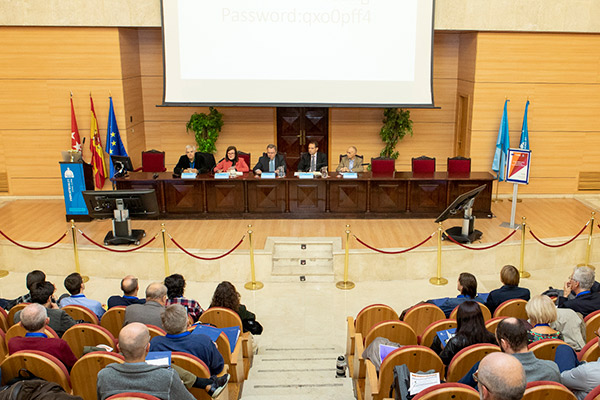COST CA17126: Towards Understanding and Modelling Intense Electronic Excitation

The First General Meeting of the COST Action CA17126 was held at Escuela Técnica Superior de Ingenieros Industriales (ETSII) belonging to Universidad Politécnica de Madrid on the 19th and 20th of November 2018.
The Action was approved on April 2018, the first Management meeting took place on September 12 and will run until September 2022. Researchers from twenty-five countries have joined the Action so far, constituting a very multidisciplinary network interested in different phenomena, effects and applications related to electronic excitation.
Almost 80 researchers from 20 different countries attended the 2-day Madrid meeting with the goal of identifying relevant cases with relevant applications in the field of electronic excitation, find multiscale methodologies to get quantitative results and enable collaborative work within the Action to implement the methodologies. The meeting program included 44 presentations, working group meetings and open discussions. Two lunches and a dinner were also organized during these sessions in order to promote networking among researchers.
Given the importance of this event, the opening session counted with the presence of relevant personalities from the host University, including Rector Cisneros, Director García (ETSII), Director Perlado (Instituto de Fusión Nuclear) and Deputy Vice-Rector Dueñas (R&D Management) and from the Spanish Ministry of Science, Director Riesgo (Research, Development and Innovation). All of them welcome the international audience and kindly supported the Action.
» READ MORE
This COST Action research network is organized in the following Working Groups (WG):
WG 1 – Experimental. Transversal activities on empirical methods to induce and characterize electronic excitation effects on solids, liquids, gases, plasmas and biological matter.
WG 2 – Electronic excitation. Typically, quantum methods to simulate the deposition of energy on the electronic system and the early stages of evolution.
WG 3 – Electron-lattice coupling. Methods to take into account energy transfer to atoms, e.g., electron-phonon coupling formalisms in condensed matter.
WG 4 – Macroscopic aspects. Methods to study long-term effects, such as hydrodynamics methods to study plasmas or heat equation to study heat dissipation.
WG 5 – Training, outreach, dissemination and technology transfer. Transversal WG to extend the Action to young researchers, general public, related scientific communities or industry.
An important goal of the Action is to establish collaboration opportunities among the WGs as a way to develop a multiscale formalism by coupling methods of the different WGs. Multidisciplinary collaboration to solve selected cases will make possible to get progress in the field and expand the successful developments to more universal formalisms with a broader scope of application.
The participants to this meeting joined and started to contribute to the WGs. This marked the first step in establishing a longer-term research platform on this critical topic. Many other researchers have shown their interest in the Action. Many of them have already started to contribute or will join in the short-term.
The Action is already offering networking tools to promote effective and fruitful collaboration, such as Short-Term Scientific Missions (STSM) and a WG meeting in Porto before the end of the winter. Participants are encouraged to make use of these tools.
Note: The European Cooperation in Science and Technology (COST) provides funding for the creation of research networks, called COST Actions. These networks offer an open space for collaboration among scientists across Europe (and beyond) and thereby give impetus to research advancements and innovation. Further info: https://www.cost.eu/
» READ LESS
